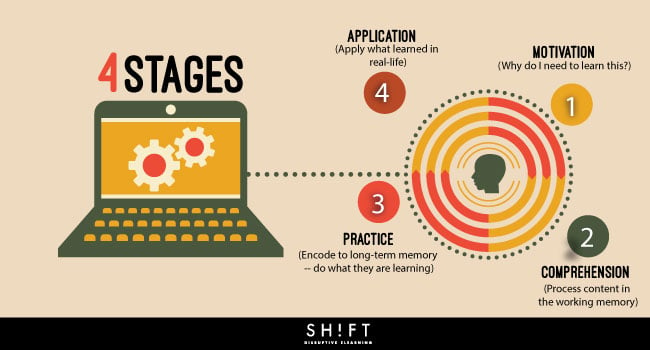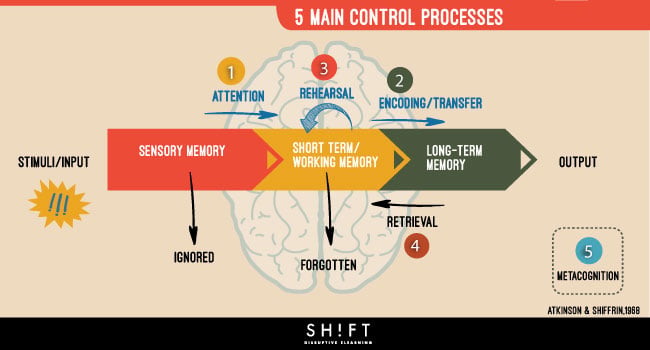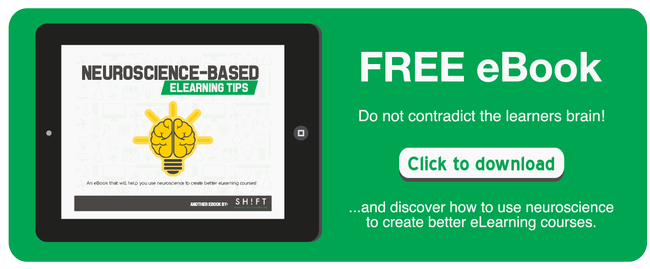Understanding how the mind processes information and stores it is vital to educators, instructional designers and eLearning professionals. Simply stated, if you don’t know how the mind works, you have no way of knowing how to design material that will ensure success for your students. Information processing theory is a subject that has been studied, discussed and debated so much that a lot of the information available conflicts. However, there are a few basic principles that are generally agreed upon.
So, how do people learn? Essentially, it works in four main stages, and five thought control processes. The four stages are motivation, comprehension, practice and application. The thought control processes are attention, encoding, rehearsal, retrieval and metacognition. When you’re creating instructional materials, you need to keep the stages and thought control processes in mind in order to best facilitate learning.
The Four Stages
In the motivation stage, you want learners to ask themselves why they need to learn the information on the course. Then, during the comprehension stage, you clarify what’s expected, and help your learners to access the information they need effectively. In the practice stage, your students rehearse ways of using the information, and receive feedback that will help them store the information in their long-term memory. And finally, in the application stage, you work on techniques for recalling the information from the long-term memory, and ways of applying that knowledge to real-life situations.

The Five Thought Control Processes
Learning, whether it’s eLearning or actually sitting down with a pile of books, follows the same basic processes. One moves from attention through encoding, rehearsal and retrieval, and finally arrives at metacognition.
Attention
In this process, the brain decides what it’s going to pay attention to, and what it’s going to ignore. This kind of selective attention determines what information is going to be moved into the brain’s short-term memory. There are several factors that determine what information will be saved:
- Is the information meaningful to the learner?
- Is there any similarity between this source of information and others that have already been processed?
- How difficult is it to process the information?
- How able is the learner to control their attention? Note that this can vary depending on the age and overall intelligence of the learner.
Without attention, there is simply no learning. So, how do you encourage attention? You should be offering fresh, exciting material, asking questions to test your students’ understanding, and then putting the new material to use by offering a problem that they can solve using the new information.
Encoding
Once the information gets past the attention stage, it’s encoded in the brain in such a way that it works with information that’s already known. Imagine, for example, that you’d never heard a dog bark. Would the phrase “He had a barking cough” have any meaning to you? Because you have heard a dog bark, you’re able to give context to the sound, and understand what’s meant by a “barking cough,” even if you’ve never heard the phrase before. This is what encoding does – it connects new information to old information. Encoded information is easier to retrieve.
Essentially, then, what you want to do as an eLearning professional is relate new information and old information, so that it can “attach” in the brain’s memory banks.
Rehearsal
Once the information is attached, rehearsal is the method by which short-term memory is transferred into long-term memory. This involves repeating the information in ways that are relevant to the student. You want to connect the information that’s just been learned and placed in the short-term memory with experiences that the student can relate to. This is sometimes termed “use level” learning. For this to be truly effective, it’s advisable for students to take breaks or alternate using the information with other activities. This method is more fully described in this interesting paper.
Retrieval
Memories that have been stored must, of course, be retrievable. This means transferring the memories back from the long-term memory to the working memory. Material is considered to be learned when it can pass easily from long-term memory to working memory and back again.
To encourage retrieval, repetition is a valuable tool. But this doesn’t mean drilling information into your students. Rather, you can facilitate retrieval skills by means of multiple-choice tests and offering different problems that basically arrive at the same solution. Relating concepts to the same subject area, to the personal experiences of your students, and to current events are effective ways of facilitating retrieval.
Check out these memory boosters.
Metacognition
Metacognition is awareness of how our cognitive system functions, and the ability to control those functions. Students essentially think about how they think. They’re able to reflect on the process of learning, evaluate the feedback that you’ve provided, and adjust their study strategies accordingly.
As a training professional, you can encourage eLearning development by means of self-checks and quizzes that will help your students determine what information needs to be taken away from the lesson.

Conclusion
Knowing how people learn is just part of facilitating eLearning development. Your goal is to help your students to learn, and also to monitor their learning effectively. By understanding the four stages and the five control processes, you’ll be a more effective professional and your students will benefit.
References:
Information Processing and Memory: Theory and Applications
Practice Makes Learning: Designing Effective Learning Activities By Judy Neill
Building on What We Know: Cognitive Processing



